The Sage Extract Market is estimated to be valued at USD 5.3 billion in 2025 and is projected to reach USD 8.7 billion by 2035, registering a compound annual growth rate (CAGR) of 5.2% over the forecast period.
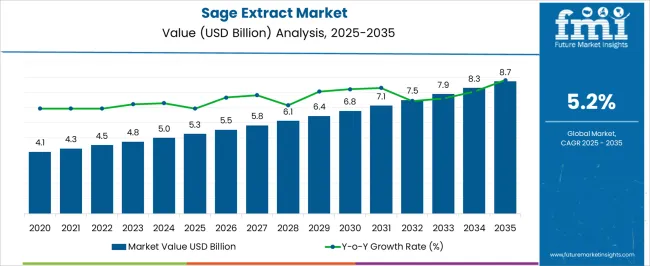
| Metric | Value |
|---|---|
| Sage Extract Market Estimated Value in (2025 E) | USD 5.3 billion |
| Sage Extract Market Forecast Value in (2035 F) | USD 8.7 billion |
| Forecast CAGR (2025 to 2035) | 5.2% |
The Sage Extract market is experiencing steady growth driven by rising consumer preference for natural and plant-based ingredients across food, beverage, and nutraceutical industries. Increasing awareness regarding the health benefits of sage, including its antioxidant, anti-inflammatory, and cognitive support properties, is further enhancing demand.
Growth is also supported by the trend toward clean-label products and the incorporation of herbal extracts in functional foods and beverages. Investments in organic farming and sustainable sourcing of sage are enabling manufacturers to meet the demand for high-quality extracts.
The market is further shaped by innovation in processing technologies, which allow the production of highly concentrated and standardized extracts with consistent efficacy As consumer interest in wellness and natural alternatives continues to expand, the Sage Extract market is poised for ongoing growth, with opportunities emerging in product diversification, functional ingredient applications, and premium packaging solutions that enhance product stability and shelf life.
The sage extract market is segmented by end use industries, nature of production, packaging, distribution channel, and geographic regions. By end use industries, sage extract market is divided into Sage Extract for Food And Beverage, Sage Extract for Pharmaceuticals, and Sage Extract for Cosmeceuticals. In terms of nature of production, sage extract market is classified into Organic Sage Extract and Conventional Sage Extract. Based on packaging, sage extract market is segmented into Amber Glass Sage Extract Bottle, Sage Extract Bottle with Dropper, and Plastic Sage Extract Bottle. By distribution channel, sage extract market is segmented into Sage Extract Sales via Online Retailers, Sage Extract Sales via Supermarkets, Sage Extract Sales via Specialty Stores, Sage Extract Sales via Grocery Stores, and Sage Extract Sales via Other Distribution Channels. Regionally, the sage extract industry is classified into North America, Latin America, Western Europe, Eastern Europe, Balkan & Baltic Countries, Russia & Belarus, Central Asia, East Asia, South Asia & Pacific, and the Middle East & Africa.
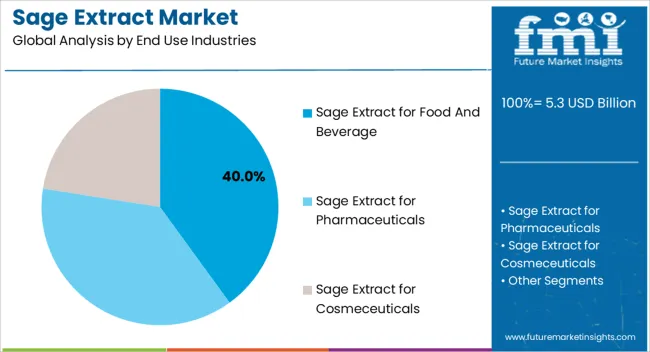
The Sage Extract for Food and Beverage end-use industry is projected to hold 40.00% of the market revenue share in 2025, making it the leading segment. This prominence is being driven by the increasing incorporation of sage extract as a natural flavoring, preservative, and functional ingredient in various food and beverage formulations. The segment’s growth has been reinforced by the rising consumer demand for natural and plant-based ingredients, particularly in health-conscious and wellness-oriented products.
Manufacturers are adopting sage extract in beverages, dairy products, confectionery, and culinary applications to enhance taste and deliver additional health benefits. The versatility of sage extract allows it to be blended seamlessly with other natural ingredients, increasing its utility in product innovation.
Additionally, food and beverage companies are increasingly seeking organic and sustainably sourced ingredients, which aligns with the market’s trend toward cleaner, more natural formulations The segment’s growth trajectory is expected to continue as end-users prioritize ingredient transparency, functional benefits, and product differentiation through natural extracts.
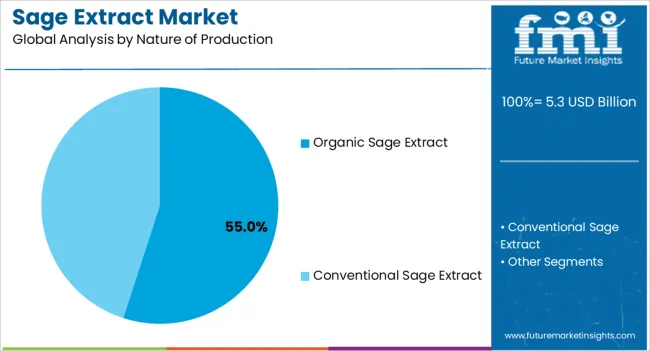
The Organic Sage Extract segment is anticipated to capture 55.00% of the Sage Extract market revenue in 2025, positioning it as the largest production type segment. The segment’s leadership is being supported by consumer preference for organically produced herbal ingredients that are free from synthetic additives, pesticides, and chemical residues.
Demand for organic sage extract is being reinforced by health-conscious consumers who associate organic products with higher quality and improved safety profiles. Additionally, manufacturers are increasingly sourcing organic sage extract to meet regulatory standards and to appeal to premium product segments in the food, beverage, and nutraceutical industries.
Organic production practices also allow for sustainable farming and traceability, which are becoming critical purchasing criteria for both businesses and end consumers The growth of this segment is expected to continue as awareness regarding the benefits of organic ingredients rises, supported by the expansion of retail and online distribution channels that promote natural and sustainable herbal extracts.
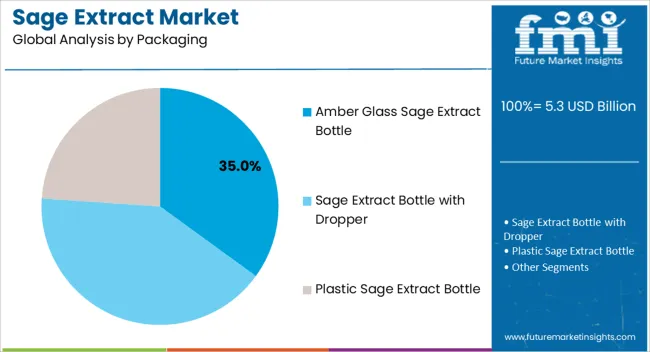
The Amber Glass Sage Extract Bottle packaging segment is projected to hold 35.00% of the market revenue share in 2025, emerging as the leading packaging format. This dominance is being driven by its ability to protect sage extract from light and oxidation, thereby preserving its potency, flavor, and shelf life.
Amber glass packaging is preferred for high-quality and premium extract products, as it enhances product stability and aligns with consumer expectations for natural and safe packaging materials. The segment’s growth has been supported by increasing adoption in food, beverage, nutraceutical, and cosmetic industries, where maintaining extract integrity is critical.
Additionally, amber glass bottles are compatible with sustainable and recyclable packaging initiatives, making them attractive to environmentally conscious manufacturers and consumers The segment is expected to continue its growth trajectory as the market focuses on premiumization, product safety, and environmentally responsible packaging solutions that support both brand positioning and product efficacy.
Sage is a low-growing evergreen shrub that has been known for centuries for its traditional uses in culinary and herbal medicines. It belongs to the mint family alongside herbs such as rosemary, thyme, basil, and oregano. The leaves of sage can be used for various purposes in different forms. For instance, they can be chewed whole.
They can also be dried and ground into powder or prepared as a fluid extract, tincture, or essential oil. The extract obtained from sage is colorless to a yellow clear liquid. The usage of sage extract in liquid form is trending nowadays. It is used as a dietary supplement and food ingredient in the USA
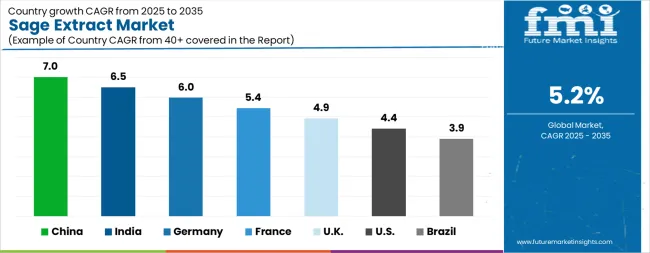
| Country | CAGR |
|---|---|
| China | 7.0% |
| India | 6.5% |
| Germany | 6.0% |
| France | 5.4% |
| UK | 4.9% |
| USA | 4.4% |
| Brazil | 3.9% |
The Sage Extract Market is expected to register a CAGR of 5.2% during the forecast period, exhibiting varied country level momentum. China leads with the highest CAGR of 7.0%, followed by India at 6.5%. Developed markets such as Germany, France, and the UK continue to expand steadily, while the USA is likely to grow at consistent rates. Brazil posts the lowest CAGR at 3.9%, yet still underscores a broadly positive trajectory for the global Sage Extract Market. In 2024, Germany held a dominant revenue in the Western Europe market and is expected to grow with a CAGR of 6.0%. The USA Sage Extract Market is estimated to be valued at USD 1.9 billion in 2025 and is anticipated to reach a valuation of USD 3.0 billion by 2035. Sales are projected to rise at a CAGR of 4.4% over the forecast period between 2025 and 2035. While Japan and South Korea markets are estimated to be valued at USD 250.8 million and USD 161.6 million respectively in 2025.
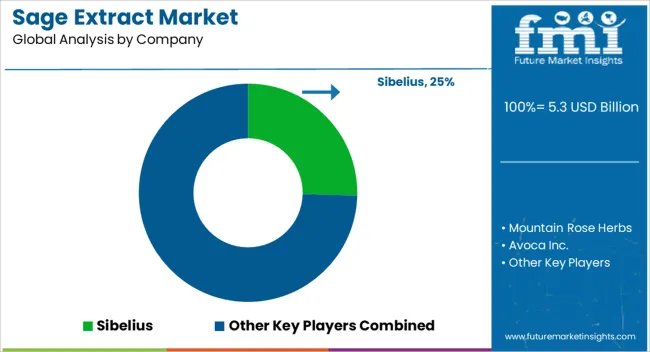
| Item | Value |
|---|---|
| Quantitative Units | USD 5.3 Billion |
| End Use Industries | Sage Extract for Food And Beverage, Sage Extract for Pharmaceuticals, and Sage Extract for Cosmeceuticals |
| Nature of Production | Organic Sage Extract and Conventional Sage Extract |
| Packaging | Amber Glass Sage Extract Bottle, Sage Extract Bottle with Dropper, and Plastic Sage Extract Bottle |
| Distribution Channel | Sage Extract Sales via Online Retailers, Sage Extract Sales via Supermarkets, Sage Extract Sales via Specialty Stores, Sage Extract Sales via Grocery Stores, and Sage Extract Sales via Other Distribution Channels |
| Regions Covered | North America, Europe, Asia-Pacific, Latin America, Middle East & Africa |
| Country Covered | United States, Canada, Germany, France, United Kingdom, China, Japan, India, Brazil, South Africa |
| Key Companies Profiled | Sibelius, Mountain Rose Herbs, Avoca Inc., Aphios Corporation, Wuhan Dahua, App Chem-Bio, Greenlife, Shanxi Jinjin, Haotian, Capot, and Sami Labs Limited |
The global sage extract market is estimated to be valued at USD 5.3 billion in 2025.
The market size for the sage extract market is projected to reach USD 8.7 billion by 2035.
The sage extract market is expected to grow at a 5.2% CAGR between 2025 and 2035.
The key product types in sage extract market are sage extract for food and beverage, sage extract for pharmaceuticals and sage extract for cosmeceuticals.
In terms of nature of production, organic sage extract segment to command 55.0% share in the sage extract market in 2025.






Our Research Products

The "Full Research Suite" delivers actionable market intel, deep dives on markets or technologies, so clients act faster, cut risk, and unlock growth.

The Leaderboard benchmarks and ranks top vendors, classifying them as Established Leaders, Leading Challengers, or Disruptors & Challengers.

Locates where complements amplify value and substitutes erode it, forecasting net impact by horizon

We deliver granular, decision-grade intel: market sizing, 5-year forecasts, pricing, adoption, usage, revenue, and operational KPIs—plus competitor tracking, regulation, and value chains—across 60 countries broadly.

Spot the shifts before they hit your P&L. We track inflection points, adoption curves, pricing moves, and ecosystem plays to show where demand is heading, why it is changing, and what to do next across high-growth markets and disruptive tech

Real-time reads of user behavior. We track shifting priorities, perceptions of today’s and next-gen services, and provider experience, then pace how fast tech moves from trial to adoption, blending buyer, consumer, and channel inputs with social signals (#WhySwitch, #UX).

Partner with our analyst team to build a custom report designed around your business priorities. From analysing market trends to assessing competitors or crafting bespoke datasets, we tailor insights to your needs.
Supplier Intelligence
Discovery & Profiling
Capacity & Footprint
Performance & Risk
Compliance & Governance
Commercial Readiness
Who Supplies Whom
Scorecards & Shortlists
Playbooks & Docs
Category Intelligence
Definition & Scope
Demand & Use Cases
Cost Drivers
Market Structure
Supply Chain Map
Trade & Policy
Operating Norms
Deliverables
Buyer Intelligence
Account Basics
Spend & Scope
Procurement Model
Vendor Requirements
Terms & Policies
Entry Strategy
Pain Points & Triggers
Outputs
Pricing Analysis
Benchmarks
Trends
Should-Cost
Indexation
Landed Cost
Commercial Terms
Deliverables
Brand Analysis
Positioning & Value Prop
Share & Presence
Customer Evidence
Go-to-Market
Digital & Reputation
Compliance & Trust
KPIs & Gaps
Outputs
Full Research Suite comprises of:
Market outlook & trends analysis
Interviews & case studies
Strategic recommendations
Vendor profiles & capabilities analysis
5-year forecasts
8 regions and 60+ country-level data splits
Market segment data splits
12 months of continuous data updates
DELIVERED AS:
PDF EXCEL ONLINE
Extraction Kits Market Analysis - Size, Share, and Forecast Outlook 2025 to 2035
Sage Essential Oil Market Analysis by Source, Application, Distribution Channel, and Region Through 2035
Extracts and Distillates Market
Dosage Cups Market Size and Share Forecast Outlook 2025 to 2035
Dosage Unit Sampling Apparatus Market Size and Share Forecast Outlook 2025 to 2035
Dosage Spoon Market Analysis by Material, Capacity, and Region through 2025 to 2035
Dosage Cup & Spoon Market Trends & Industry Growth Forecast 2024-2034
Sausage Casing Market Size and Share Forecast Outlook 2025 to 2035
Massage Therapy Service Market - Growth & Forecast 2025 to 2035
Massage Guns Market Analysis – Demand, Growth & Forecast 2025–2035
Industry Share Analysis for Massage Therapy Service Providers
Market Share Insights of Leading Sausage Casing Providers
Massage Equipment Market
Fume Extractor Market Size and Share Forecast Outlook 2025 to 2035
Meat Extracts Market Size and Share Forecast Outlook 2025 to 2035
Kale Extract Skincare Market Size and Share Forecast Outlook 2025 to 2035
Wine Extract Market Size and Share Forecast Outlook 2025 to 2035
Amla Extract Market Analysis - Size, Share, and Forecast Outlook 2025 to 2035
Dust Extractor Market Growth – Trends & Forecast 2025 to 2035
Data Extraction Software Market

Thank you!
You will receive an email from our Business Development Manager. Please be sure to check your SPAM/JUNK folder too.
Chat With
MaRIA